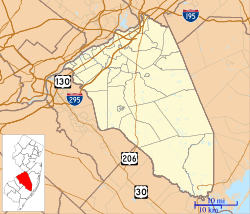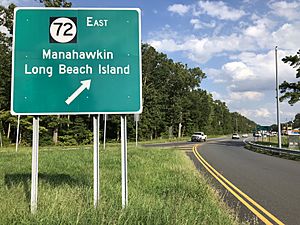Woodland Township, New Jersey facts for kids
Quick facts for kids
Woodland Township, New Jersey
|
||
|---|---|---|
|
Township
|
||
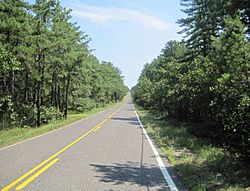
Savoy Boulevard through the Pine Barrens in Woodland Township
|
||
|
||
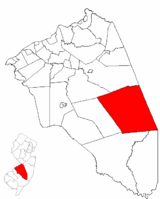
Woodland Township highlighted in Burlington County. Inset map: Burlington County highlighted in the State of New Jersey.
|
||
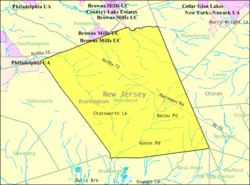
Census Bureau map of Woodland Township, New Jersey
|
||
| Country | ||
| State | ||
| County | ||
| Incorporated | March 7, 1866 | |
| Government | ||
| • Type | Township | |
| • Body | Township Committee | |
| Area | ||
| • Total | 94.45 sq mi (244.61 km2) | |
| • Land | 92.64 sq mi (239.93 km2) | |
| • Water | 1.81 sq mi (4.68 km2) 1.91% | |
| Area rank | 7th of 565 in state 2nd of 40 in county |
|
| Elevation | 118 ft (36 m) | |
| Population
(2020)
|
||
| • Total | 1,544 | |
| • Estimate
(2023)
|
1,552 | |
| • Rank | 509th of 565 in state 35th of 40 in county |
|
| • Density | 16.7/sq mi (6.4/km2) | |
| • Density rank | 563rd of 565 in state 39th of 40 in county |
|
| Time zone | UTC−05:00 (Eastern (EST)) | |
| • Summer (DST) | UTC−04:00 (Eastern (EDT)) | |
| ZIP Code |
08019 – Chatsworth
|
|
| Area code(s) | 609 | |
| FIPS code | 3400582420 | |
| GNIS feature ID | 0882080 | |
| Website | ||
Woodland Township is a township in Burlington County, in the U.S. state of New Jersey. As of the 2020 United States census, the township's population was 1,544, a decrease of 244 (−13.6%) from the 2010 census count of 1,788, which in turn reflected an increase of 618 (+52.8%) from the 1,170 counted in the 2000 census. The township, and all of Burlington County, is a part of the Philadelphia-Reading-Camden combined statistical area and the Delaware Valley.
Woodland was incorporated as a township by an act of the New Jersey Legislature on March 7, 1866, from portions of Pemberton Township, Shamong Township, Southampton Township and Washington Township. Portions of the township were taken to form Tabernacle Township on March 22, 1901.
History
The area now known as Woodland Township was originally inhabited by the Lenape Native American tribe. European settlers began arriving in the late 17th century, attracted by the fertile soil and abundant lumber resources. The settlers cleared land for farming and built homes and other structures using local materials, including wood and sandstone.
Throughout the late 19th and early 20th centuries, Woodland was predominantly an agricultural community, with farming being the primary occupation for most residents. The fertile soil in the region was ideal for growing a variety of crops, including corn, wheat, and potatoes. In addition to crop farming, livestock, dairy, and poultry farming also played a significant role in the local economy.
In the early 20th century, several small-scale industries began to emerge in Woodland, including sawmills, gristmills, and blacksmith shops. These industries relied heavily on the local resources, such as timber and iron ore, and provided employment opportunities for the residents.
In the latter half of the 20th century, Woodland experienced a shift away from agriculture and towards a more diversified economy. Although farming remained an important aspect of the township's identity, the focus shifted to include manufacturing, retail, and service-based industries.
The township has a mix of residential, commercial, and agricultural areas, reflecting its multifaceted history. Woodland is known for its landscapes, including the scenic Brendan T. Byrne State Forest, which offers numerous recreational opportunities such as hiking, camping, and birdwatching.
Geography
According to the U.S. Census Bureau, the township had a total area of 94.45 square miles (244.61 km2), including 92.64 square miles (239.93 km2) of land and 1.81 square miles (4.68 km2) of water (1.91%).
The township borders Bass River Township, Pemberton Township, Southampton Township, Tabernacle Township, Washington Township in Burlington County; and Barnegat Township, Lacey Township, Little Egg Harbor Township and Manchester Township in Ocean County.
Unincorporated communities, localities and place names located partially or completely within the township include Bullock, Butlers Place, Chatsworth (the postal address for most of the residents of the township), DeCou Pond, Dukes Bridge, Four Mile, Goose Pond, Hedger House, Johnson Place, Jones Mill, Lebanon, Long Causeway, Old Halfway, South Park and Woodmansie.
The township is one of 56 South Jersey municipalities that are included within the New Jersey Pinelands National Reserve, a protected natural area of unique ecology covering 1,100,000 acres (450,000 ha), that has been classified as a United States Biosphere Reserve and established by Congress in 1978 as the nation's first National Reserve. All of the township is included in the state-designated Pinelands Area, which includes portions of Burlington County, along with areas in Atlantic, Camden, Cape May, Cumberland, Gloucester and Ocean counties.
Demographics
| Historical population | |||
|---|---|---|---|
| Census | Pop. | %± | |
| 1870 | 389 | — | |
| 1880 | 325 | −16.5% | |
| 1890 | 327 | 0.6% | |
| 1900 | 475 | 45.3% | |
| 1910 | 548 | * | 15.4% |
| 1920 | 970 | 77.0% | |
| 1930 | 970 | 0.0% | |
| 1940 | 1,374 | 41.6% | |
| 1950 | 1,524 | 10.9% | |
| 1960 | 1,904 | 24.9% | |
| 1970 | 2,032 | 6.7% | |
| 1980 | 2,285 | 12.5% | |
| 1990 | 2,063 | −9.7% | |
| 2000 | 1,170 | −43.3% | |
| 2010 | 1,788 | 52.8% | |
| 2020 | 1,554 | −13.1% | |
| 2023 (est.) | 1,552 | −13.2% | |
| Population sources:1870–2000 1870–1920 1870 1880–1890 1890–1910 1910–1930 1940–2000 2000 2010 2020 * = Lost territory in previous decade. |
|||
2010 census
The 2010 United States census counted 1,788 people, 476 households, and 359 families in the township. The population density was 18.9 per square mile (7.3/km2). There were 494 housing units at an average density of 5.2 per square mile (2.0/km2). The racial makeup was 89.60% (1,602) White, 8.11% (145) Black or African American, 0.06% (1) Native American, 0.84% (15) Asian, 0.00% (0) Pacific Islander, 0.45% (8) from other races, and 0.95% (17) from two or more races. Hispanic or Latino of any race were 4.81% (86) of the population.
Of the 476 households, 30.5% had children under the age of 18; 60.7% were married couples living together; 8.2% had a female householder with no husband present and 24.6% were non-families. Of all households, 17.9% were made up of individuals and 5.5% had someone living alone who was 65 years of age or older. The average household size was 2.76 and the average family size was 3.14.
20.2% of the population were under the age of 18, 6.3% from 18 to 24, 25.6% from 25 to 44, 37.4% from 45 to 64, and 10.5% who were 65 years of age or older. The median age was 43.3 years. For every 100 females, the population had 152.9 males. For every 100 females ages 18 and older there were 166.0 males.
The Census Bureau's 2006–2010 American Community Survey showed that (in 2010 inflation-adjusted dollars) median household income was $65,568 (with a margin of error of +/− $16,290) and the median family income was $96,875 (+/− $31,126). Males had a median income of $61,250 (+/− $11,359) versus $33,393 (+/− $4,757) for females. The per capita income for the borough was $33,552 (+/− $5,866). About 4.9% of families and 4.6% of the population were below the poverty line, including 8.6% of those under age 18 and 9.7% of those age 65 or over.
Education
The Woodland Township School District serves students in pre-kindergarten through eighth grade at Chatsworth Elementary School. As of the 2020–21 school year, the district, comprised of one school, had an enrollment of 120 students and 16.8 classroom teachers (on an FTE basis), for a student–teacher ratio of 7.1:1. In the 2016–2017 school year, Woodland had the 24th smallest enrollment of any school district in the state, with 147 students.
Public school students from Woodland Township in ninth through twelfth grades attend Seneca High School, located in Tabernacle Township, which also serves students from Shamong Township, Southampton Township and Tabernacle Townships. The school is part of the Lenape Regional High School District, which also serves students from Evesham Township, Medford Lakes, Medford Township and Mount Laurel Township. As of the 2020–21 school year, the high school had an enrollment of 1,073 students and 103.6 classroom teachers (on an FTE basis), for a student–teacher ratio of 10.4:1.
Students from Woodland Township, and from all of Burlington County, are eligible to attend the Burlington County Institute of Technology, a countywide public school district that serves the vocational and technical education needs of students at the high school and post-secondary level at its campuses in Medford and Westampton.
Transportation
As of May 2010[update], the township had a total of 73.73 miles (118.66 km) of roadways, of which 44.75 miles (72.02 km) were maintained by the municipality, 15.47 miles (24.90 km) by Burlington County and 13.51 miles (21.74 km) by the New Jersey Department of Transportation.
Two major state routes and two additional significant county routes pass through Woodland Township. Route 70 runs along the northwestern border while Route 72 travels from the northwest to the southeast. CR 532 and CR 563 also pass through and intersect with each other in Chatsworth. Four Mile Circle is a traffic circle located at the junction of Route 70, Route 72, Buddtown Road (County Route 644), and New Lisbon Road (County Route 646).
The Garden State Parkway is the closest limited-access highway. It is accessible via neighboring Lacey, Barnegat, Stafford, Little Egg Harbor and Bass River Townships.
See also
 In Spanish: Municipio de Woodland (Nueva Jersey) para niños
In Spanish: Municipio de Woodland (Nueva Jersey) para niños



